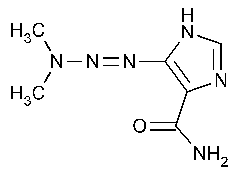Dacarbazine
1H-Imidazole-4-carboxamide,5-(3,3-dimethyl-1-triazenyl)-.
5-(3,3-Dimethyl-1-triazeno)imidazole-4-carboxamide [4342-03-04].
»Dacarbazine contains not less than 97.0percent and not more than 102.0percent of C6H10N6O.
Caution—Great care should be taken in handling Dacarbazine,as it is a potent cytotoxic agent.
Packaging and storage—
Preserve in tight,light-resistant containers,in a refrigerator.
USP Reference standards á11ñ—
USP Dacarbazine RS.USP Dacarbazine Related Compound A RS.USP Dacarbazine Related Compound B RS.
Identification—
The IRabsorption spectrum of a potassium bromide dispersion of it exhibits maxima only at the same wavelengths as that of a similar preparation of USP Dacarbazine RS.
Residue on ignition á281ñ:
not more than 0.1%.
Related compounds—
Dissolve an accurately weighed quantity of Dacarbazine in 0.1Nhydrochloric acid to obtain a solution having a concentration of 40mg per mL,and apply 5µLof the solution to a suitable thin-layer chromatographic plate (see Chromatography á621ñ)coated with a 0.25-mm layer of chromatographic silica gel mixture.Apply,separately,5µLof a methanolic solution containing 0.40mg of USP Dacarbazine Related Compound A RSper mL,and 5µLof an aqueous solution containing 0.40mg of USP Dacarbazine Related Compound B RSper mL.Develop the chromatogram in a mixture of butanol,water,and acetic acid (5:2:1),until the solvent front has moved about three-fourths of the length of the plate.Remove the plate from the developing chamber,mark the solvent front,and allow the solvent to evaporate.Locate the spots on the plate by viewing under short-wavelength UVlight:any spots obtained from the test solution are not greater in size or intensity than the spots,occurring at the respective RFvalues,produced by the Standard solutions,corresponding to not more than 1.0%of dacarbazine related compound Aand not more than 1.0%of dacarbazine related compound B.
Assay—
[NOTE—Throughout this procedure,avoid exposing Dacarbazine and its solutions to light.]
Standard preparations—
Transfer about 30mg of USP Dacarbazine RS,accurately weighed,to a 50-mLvolumetric flask,add 0.1Nhydrochloric acid to volume,and mix (Standard stock solution).Dilute a portion of Standard stock solutionquantitatively and stepwise with 0.1Nhydrochloric acid to obtain an Acidic standard preparationhaving a known concentration of about 6µg per mL.Dilute a portion of Standard stock solutionquantitatively and stepwise with pH7.0phosphate buffer (see Buffer Solutionsin the section Reagents,Indicators,and Solutions)to obtain a Neutral standard preparationhaving a known concentration of about 6µg per mL.
Assay preparations—
Prepare as directed under Standard preparations,except to use about 30mg of Dacarbazine,accurately weighed.
Procedure—
Concomitantly determine the absorbances of the Acidic standard preparationand the Acidic assay preparationin 1-cm cells at the wavelength of maximum absorbance at about 323nm,with a suitable spectrophotometer,using 0.1Nhydrochloric acid as the blank.Concomitantly determine the absorbances of the Neutral standard preparationand the Neutral assay preparationin 1-cm cells at the wavelength of maximum absorbance at about 329nm,using pH7.0phosphate buffer (see Buffer Solutionsin the section Reagents,Indicators,and Solutions)as the blank.Calculate the quantity,in mg,of C6H10N6Oin the portion of Dacarbazine taken by the formula:
5C[(A323+A329)U/(A323+A329)S],
in which Cis the concentration,in µg per mL,of USP Dacarbazine RSin the Standard preparations,and the parenthetic expressions are the sums of the absorbances of the Assay preparations(U)and the Standard preparations(S),respectively,measured at the wavelengths indicated by the subscripts.
Auxiliary Information—
Staff Liaison:Lawrence Evans,III,Ph.D.,Scientist
Expert Committee:(PA6)Pharmaceutical Analysis 6
USP28–NF23Page 568
Phone Number:1-301-816-8389
